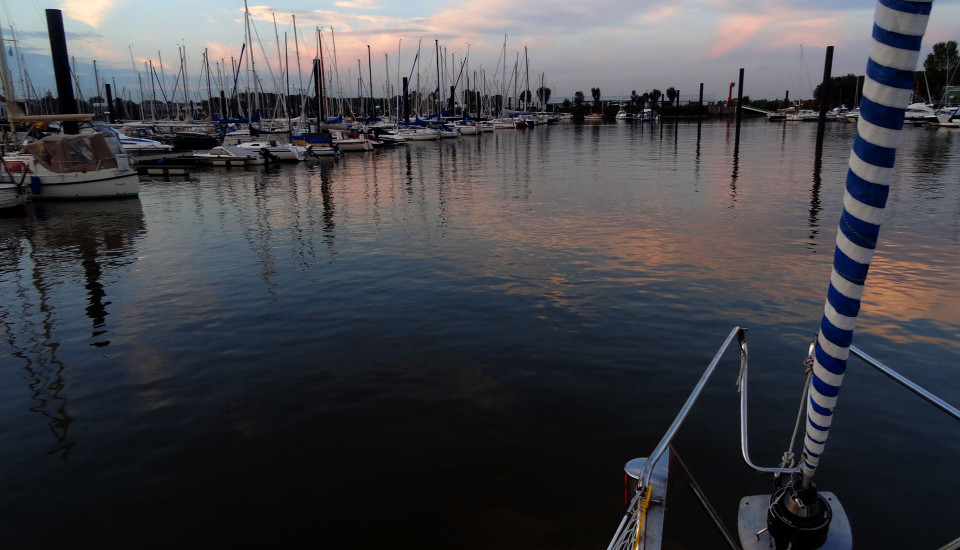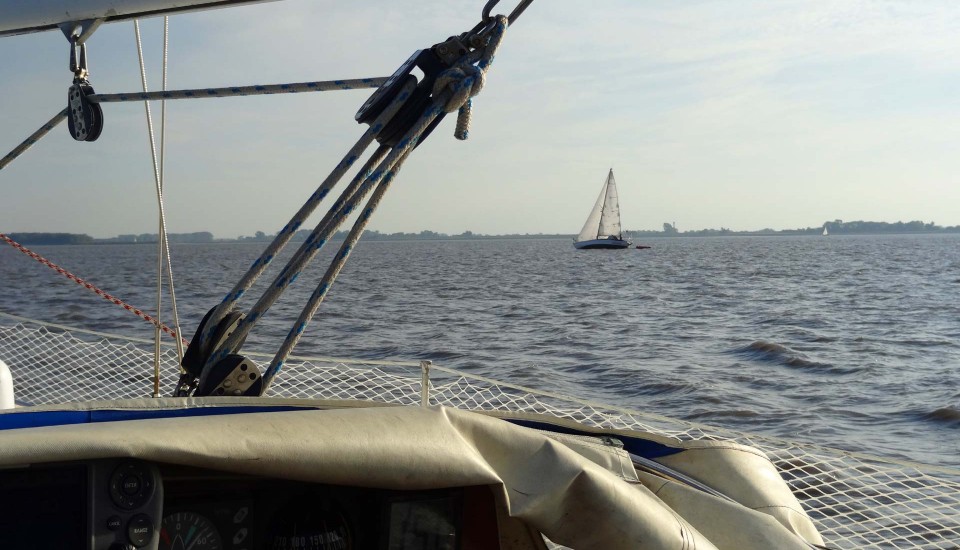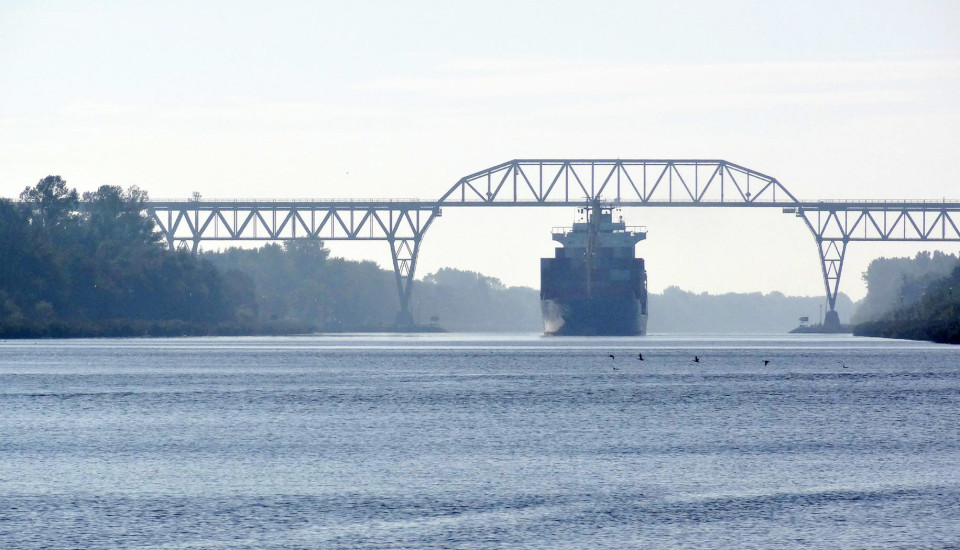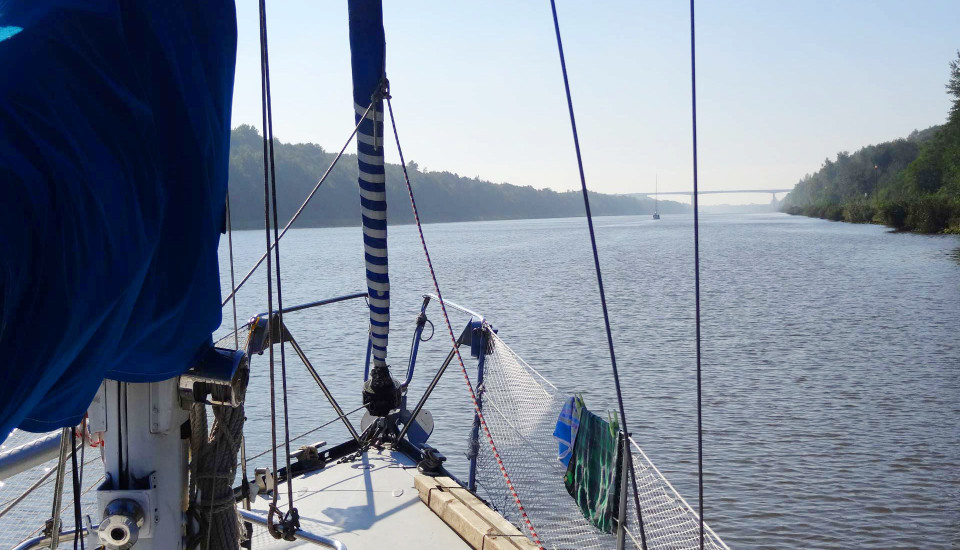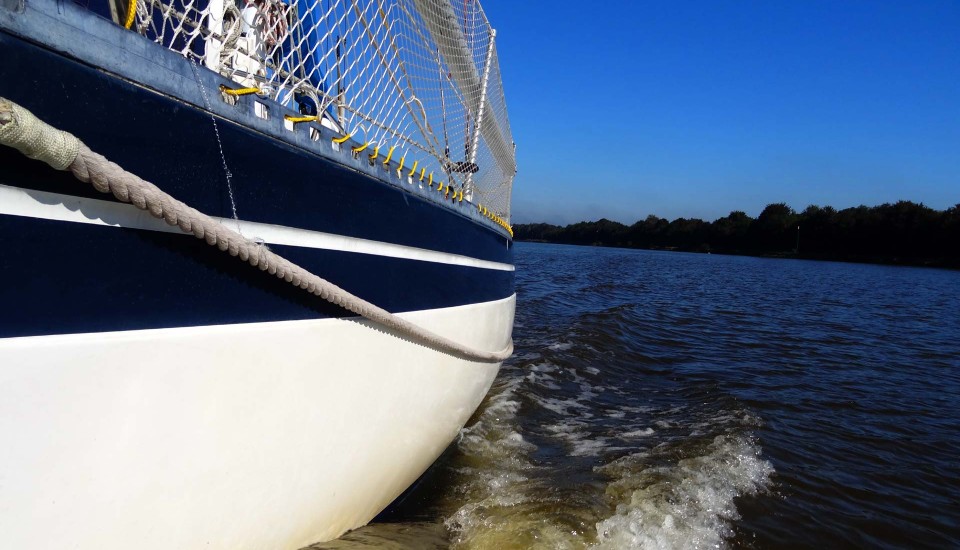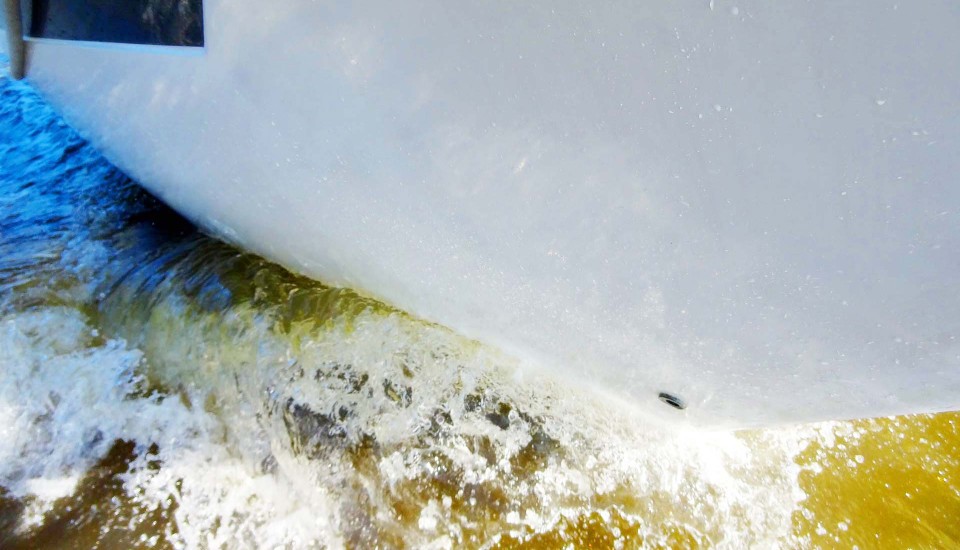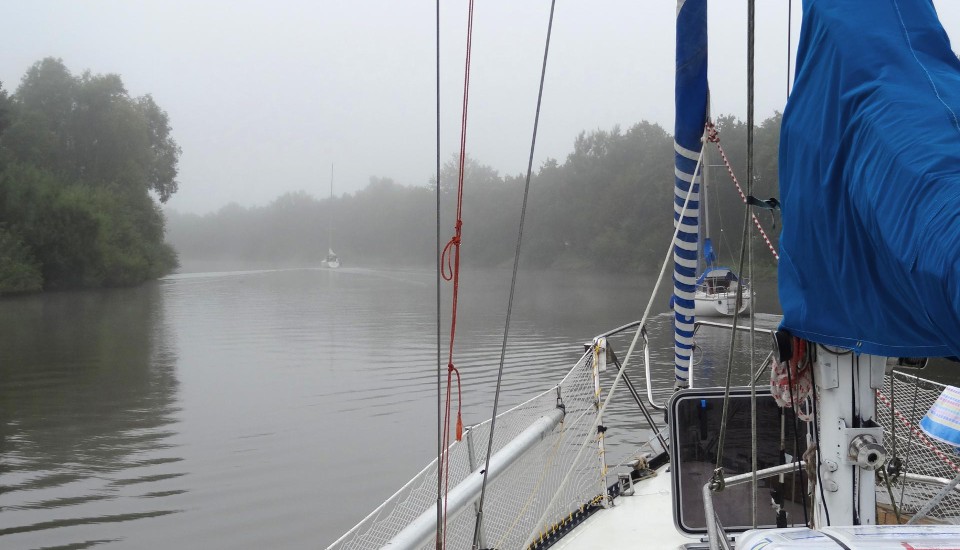That´s it. The end. We´ve arrived in Hamburg, finally, the new homeport of our yacht OLIVIA. It have been three thrilling days full of colourful pictures, adventure, leisure-time and a load full of learnings especially for me as a newbie in sailing. Day 1 (the whole story might be read here) took us from the beautiful Schlei of her pre-owner´s port to Kiel, where we did the locking into Kiel Canal to cross the busiest waterway of the world during day 2 (which may be read here).
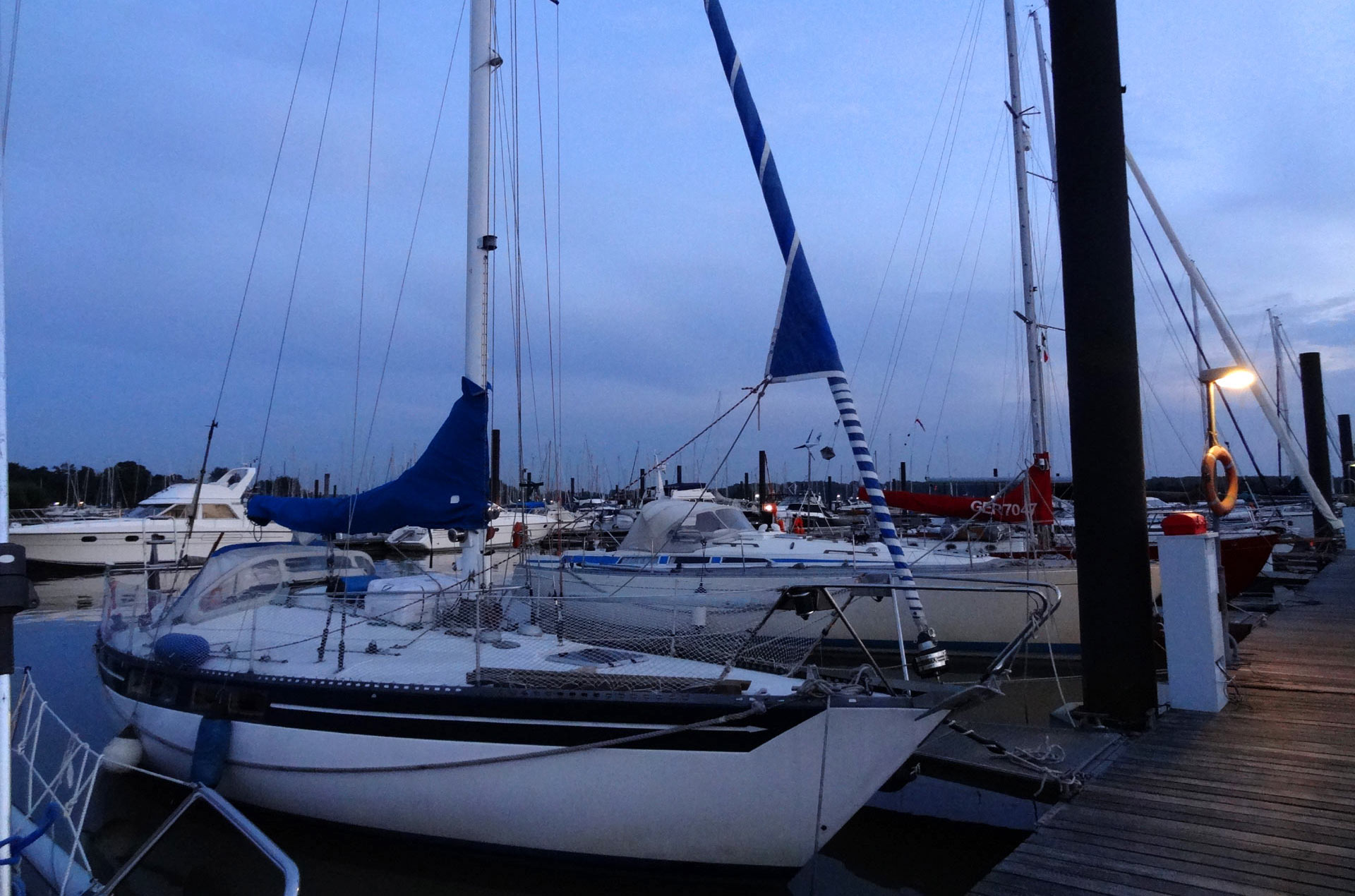
And now we´re home again: 130 miles, most of them under engine, us 4 crewmembers on board the fine King´s Cruiser 33 lived up to the spirit of sailing. Here is how we´ve spent the final third day – told from the finish mooring in Yachthafen Hamburg to the start in the Kiel Canal.
Home, sweet floating home …
I´m awake. Very well aware of the slight up and down of OLIVIA which I take so common after three days on board. The swell here inside the marina is heavier than experienced in the Schlei, Kiel or Gieselaukanal the nights before – but River Elbe is a tidal water and thus heavily used by the biggest container ships and other commercial craft causing the boats mooring here in Hamburg harbour to move harder. But I liked it.
We´ve decided to stay on board and spend another, fourth night here after we said goodbye to the Pilot whose wife arrived to collect her sailor yesterday evening. We spent some hours after securely mooring the boat sitting together in the harbour´s restaurant, talking about the trip and having dinner. Of course: All of us with a big pint of fresh, cold beer.
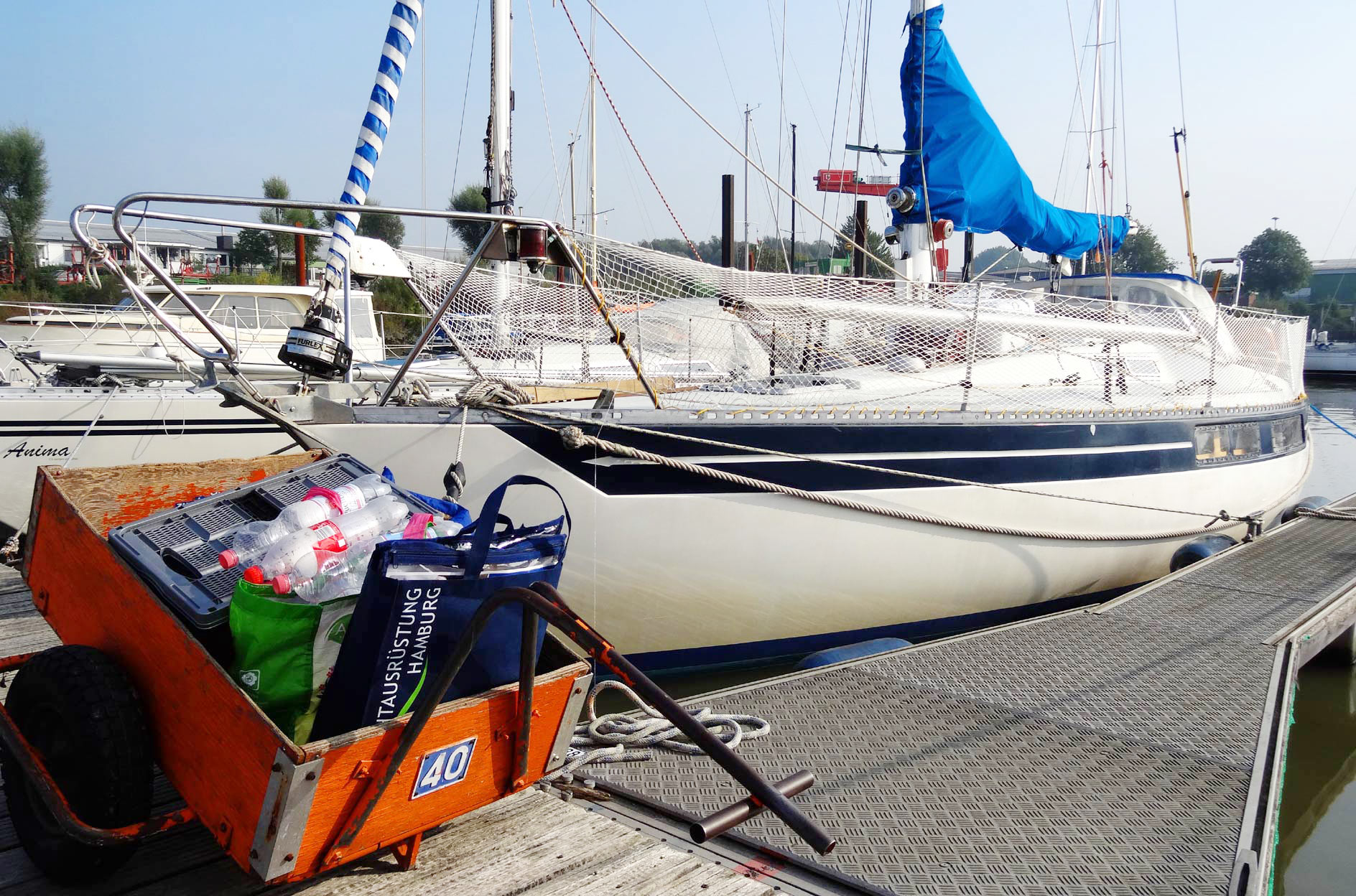
I begin to unload OLIVIA, unship her uneaten provisions of which I was having way too much on board. We nearly consumed all of the water and (surprisingly) some 10 litres of Coke, but none of the apple- and orangejuice. We drank no tea at all but ran out of coffee today after breakfast. Some 5 kilograms of pasta uneaten, the same with sauces, pickles and half of all the bread I´ve had ready to eat in OLIVIAs stowage. Taking off all clothing and personal belongings from the ship came with a sad feeling: As our car was loaded, our boat was up high in the water again, unburdened from nearly half of her 100 litres of Diesel and all of her crew´s luggage.
Although we miraculously managed to complete the transfer from the Baltic Sea to Hamburg in 3 rather than in 4 or anticipated 5 days, I knew that the upcoming week was going to be a complete opposite from what we´ve experienced so far. I will have 2 days from now on to make everything clear for the Rigger, another day for de-masting and prepping for winter storage and in four days I had a tiny timeframe for craning and transporting OLIVIA to her winter storage (which can be read here).
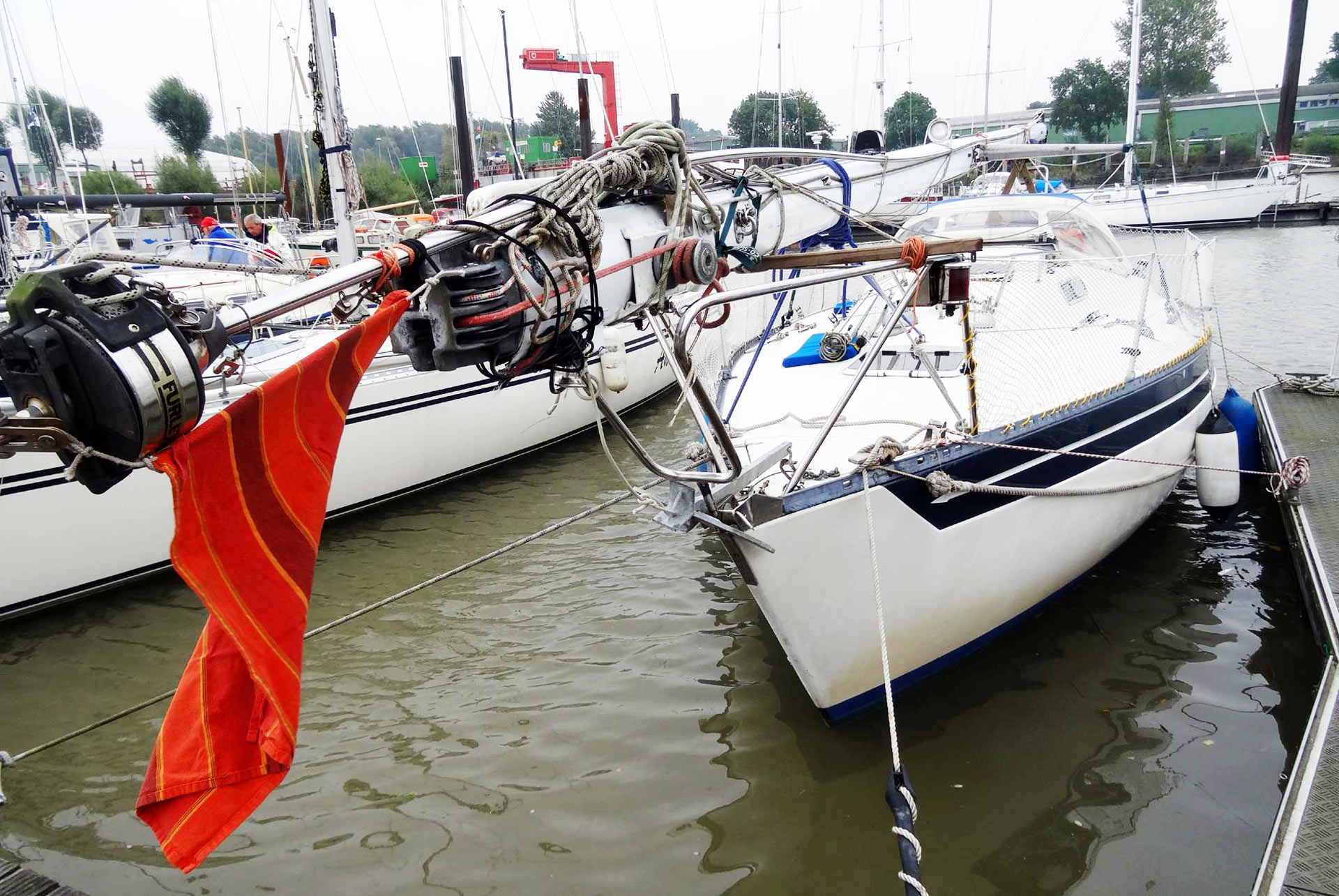
Running not less than five times heavily loaded with stuff to our car, there was much time to recall yesterday …
Reaching home-port dead on time.
Sun went down quickly that day, an unerringly sign that winter is approaching fast. My heart was beating fast as I hop off our boat to catch the ropes to secure her temporarily to the pierside. “Let´s take a look onto our berth from landside”, the Pilot was proposing. A good choice: Instead of curving about inside the poky marina and picking in the cramped berth we walked leisurely to inspect our berth: 186B. “It´s wide and comfortable – no problem”, we stated and returned on board.

Maneuvering the boat into her berth was a no brainer for the Pilot, his last act a part-time-captain of OLIVIA. Next time it will be my duty to safely bring her in and out harbours: “Remember”, he said, “slow is safe. Don´t hustle. Always pre-think your actions and talk them through with your crew. Don´t act without a plan – even apparently easy tasks can turn into complete chaos when you lose control.” He was completely right. As I learned some days later during my yachtmaster´s exam (full article here) it´s the controlled, deliberate skipper who is the safe skipper.
We flushed into Hamburg harbour with virtually last sunlight. Some minutes before 7 o´clock p.m. and OLIVIA steamed through the gates, which was not without pretension: Right next to the entrance the mighty River Elbe was turning the tides from flood to low tide. The tidal current of up to 3 knots was pushing OLIVIA away from the entrance-piles. “A current is the poor man´s tug”, said the Pilot and was steering the boat with correction angle thus calculating to arrive just between the piles and “sucked” into the marina. An interesting maneuver – our engine was running on lowest throttle. Later I discovered that most of the other skippers were full flank ahead and not using the stream but sheer engine-power trying to outpower the current.
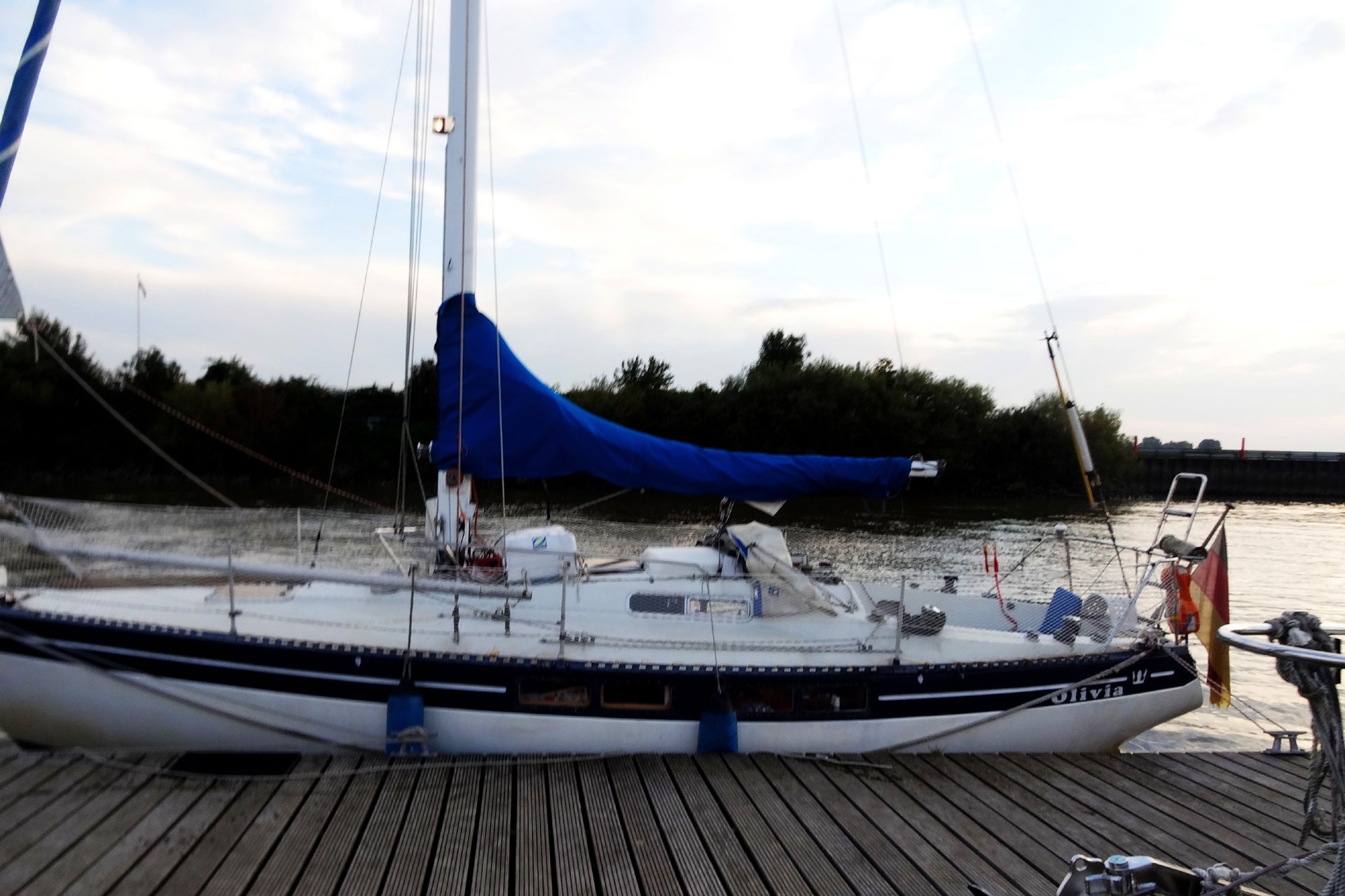
We´ve done it more elegantly, I guess. “I´ll bring her along the end of the pier, let´s have a look to our berth first. It´s already dark and I´m not familiar with that marina.” Sounds like a plan. Just two hours earlier we were slowly but constantly running behind the tidal wave, ever losing more speed over ground – we didn´t panic but time was running out: “We must not reach Hamburg after change of the tides!”, the Pilot shouted against the noise of our Volvo Penta running full throttle: “We have no chance against a 3 knot heads-on current!”
Cutting all the buoy-lines.
The clock was ticking – and we were running behind. The pilot got more and more nervous and went down to the navigation table to dead reckoning the remaining distance to Hamburg and calculating our timeframe: We had already lost most of the tidal current´s momentum and were nearly solely running on just engine with some 7 knots.
“The tidal wave is through”, the Pilot said. “Soon the tide will change and we´ll get an increasingly strong heads-on current that will slow us down to 3 knots.” And running just 3 knots over ground would mean to be slower than my own grandmother on a Sunday´s bicycle ride to her garden plot. Besides, sun was already dawning and facing the heavy traffic here on river Elbe my delight to cruise these tricky waters at night were nearing zero.
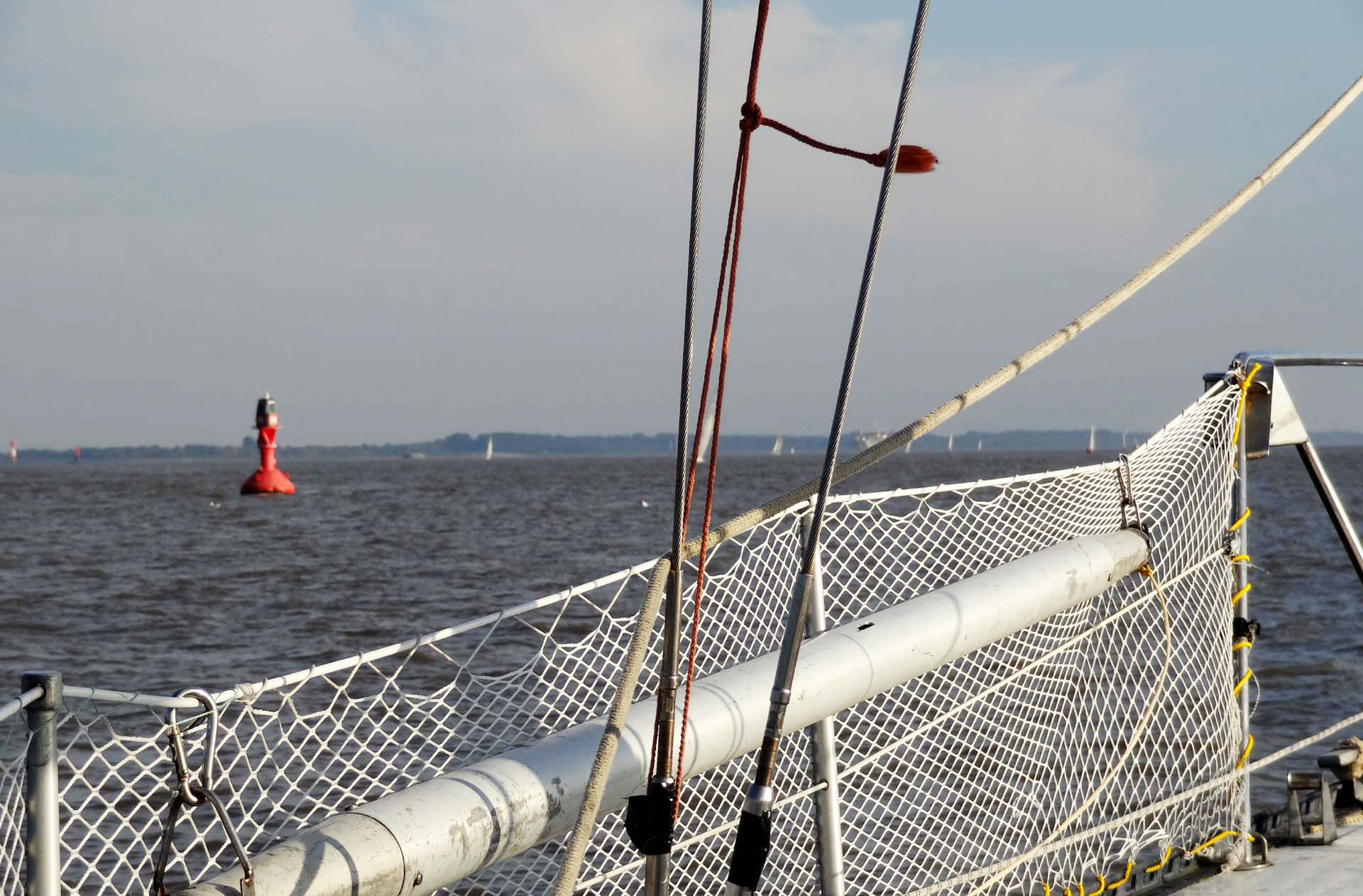
“Steer port-side bearing this big chimney.” the Pilot advised. “Aye”, said I and turned OLIVIA´s bow right into the waterway, crossing it completely and disobeying the traffic rules. There were no ships in sight and so we didn´t interfered with any of the traffic. “Keep outside the buoy-line when possible when we reach the opposite side.” Cutting another curve in a straight line by not following the order to keep on the right hand side of the river would enable us to spare some miles, thus hopefully shortening the overall length of our trip. Reaching the smokestack, the new order was to again cut the traffic by steering starboard. “Well, it´s no good seamanship”, the Pilot stated, “But losing the pushing current is definitely worse.”
“There!”, I shouted, “There´s Hamburg harbour!” – and right I was. Just about 2 or 3 miles away I could easily spot the all too familiar skyline of my city. “It´s done!”, as if a stone was relieved from my shoulders. “Well, not quite so”, the Pilot said: “We´ll have to navigate against the current to hit the narrow entrance to the marina. Will be interesting …”
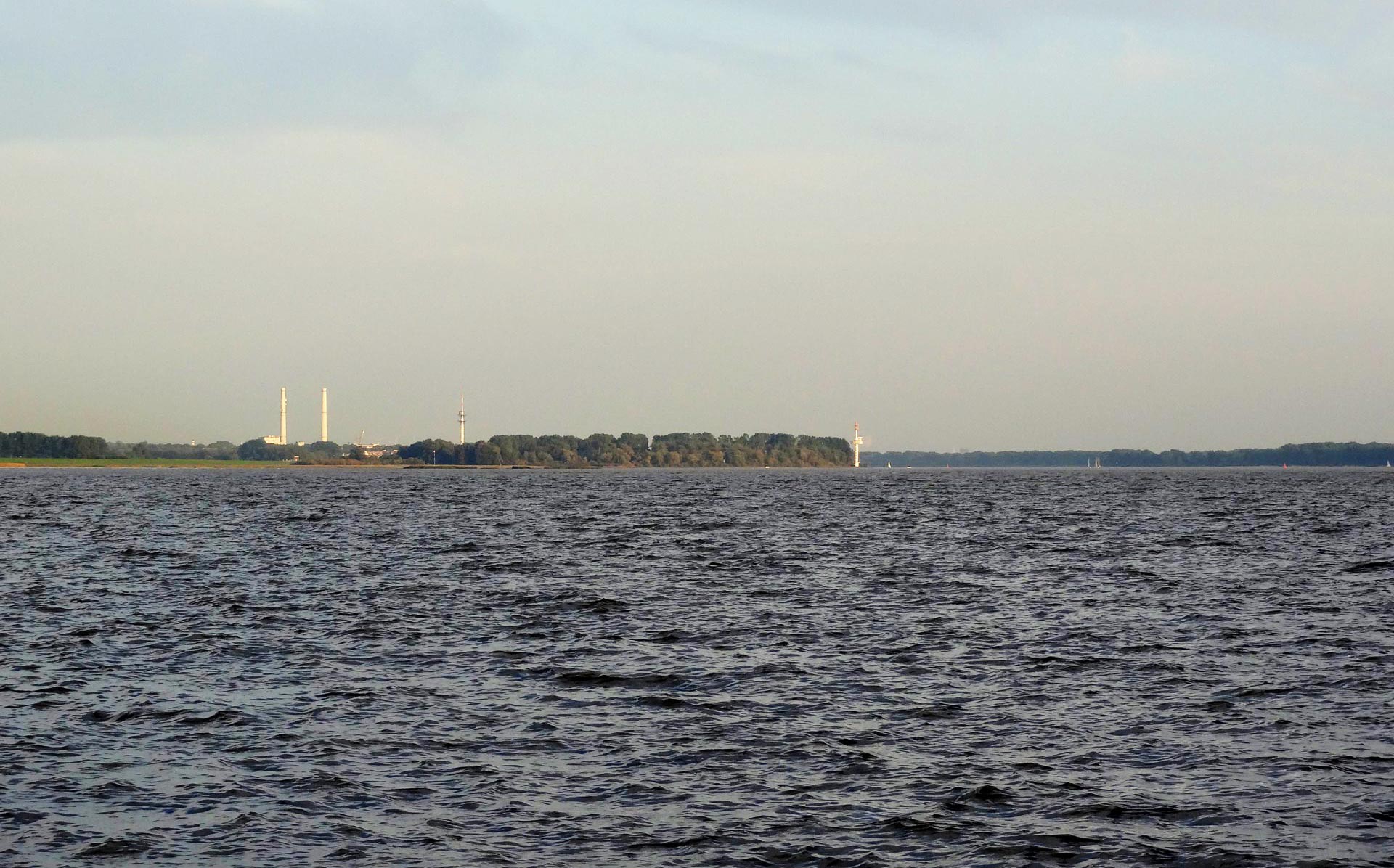
But I smiled all along the way – imagining myself at the helm just some hours before, the situation was much more strained …
Shallows, heavy traffic & buoys.
Elbe is a tricky sailing area. Very tricky and quite risky: “Here you have a lot of factors adding up: Strong tides, heavy commercial traffic and although Elbe is an industrialized river that has been modified to meet commercial demands it´s still a natural body constantly changing with hazards like shallows, local currents and other phaenomena.” Some of them I was about to experience by myself.
Lucky me: The weather was fine that particular day. We´ve had much less sunshine than yesterday but it was still dry and winds were not as strong as feared. But other things were quite demanding, such as all the different ground-conditions. The Elbe has wide shallows not deeper than 2 metres even during flood, she also has breakwaters for slowing down the river and preventing sedimentation of shores and levees – long stone-walls which get washed over during flood – invisible to the unexperienced sailor such a wall can easily rip off the keel when hit at full speed.
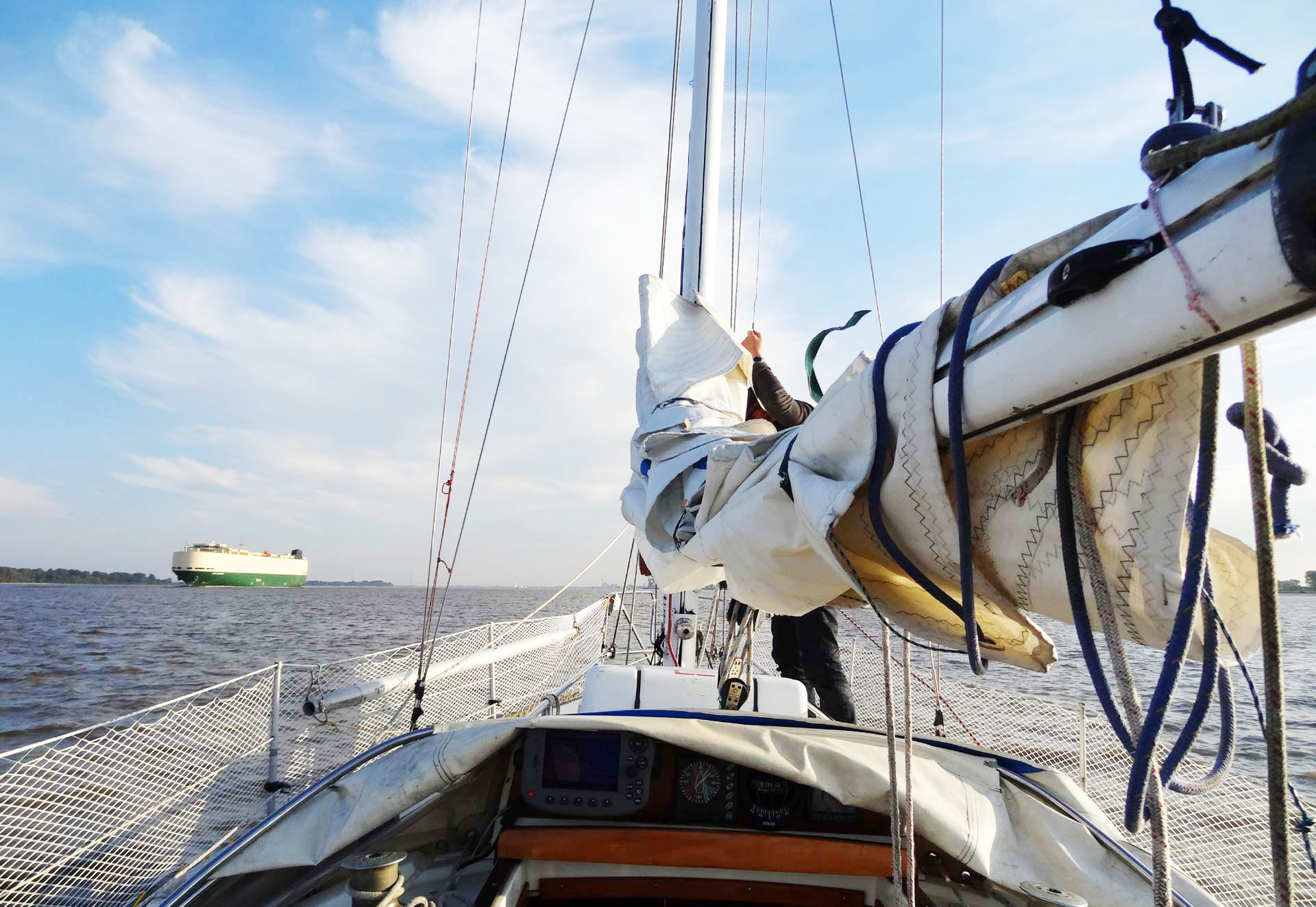
Best thing to do was to follow the line of buoys: From Buoy 51 starting off Brunsbüttel it´s mandatory to keep the red buoys close to our port-side – giving the heavy commercial traffic all the room but avoiding shallows at the same time. We´d have to count up to 122, the particular buoy that marks the entrance to Hamburg Yachthafen. Having the radio on all the time, the Pilot was able to quickly identify incoming or gaining traffic and the estimated time of arrival at our positions, warning me well in advance to keep clear of the big buffalo´s courses.
Quite stressful, compared to yesterday, I thought by myself.
Quite a different day.
Sprinting the Elbe upriver, always trying to be on top of the tidal wave, utilizing it´s push forward to reach Hamburg was a demanding task: The Pilot was always calculating not to fall behind, searching and looking for commercial traffic to cut through the waterway to spare mile after mile by straighten out most of the curves.
I was constantly checking engine temperature, filling level of our Diesel tank and oil-pressure – if our engine would die off right now, we´d have a big chunk of problems. Not to imagine the trouble we´d get if we would lose both engine power and maneuverability. Floating about motionless and waiting for help could hold up commercial traffic – ships which are dependent on deepwater couldn’t be delayed, couldn´t be upheld or maneuver inside the narrow waterway. I quickly dismissed these thoughts and focused my attention to helming the boat.
Besides traffic, it was also much more water movement: Elbe is a river, no ocean, but we were experiencing both higher and shorter waves right now, making the movements of our ship more uncomfy than 2 days before on the Baltic Sea. We forgot time. As the Pilot took over once again, I instantly felt an aching hunger inside my stomach. Under heavy cramps I asked: “Anyone hungry?”. All were chanting “Yeah!” and I started to prepare big sandwiches packed over and over again with layers of Italian Salami and swiss cheese. They ate with joy, both demanding a second sandwich immediately, gorging them down within seconds.

“Wow, you really forget to eat and drink”, I stated. The Pilot nodded, his mouth filled with tasty black bread-sandwich. “Thatswhy OLIVIA has not less than 4 thermos jugs when you bought her.” Right, that’s quite a different day in every aspect of sailing than yesterday – different area, different sounds, different approach and demands. Even hunger felt different.
Swell´n´rumble.
“Steer her right into the wave – NOW!”, the Pilot was screaming from below. Me at the helm, I instantly swung her rudder to hard port-side. A big commercial ship had passed by one minute or so ago, leaving a big wake behind for us. The swell was now rolling up our way, gaining distance every second, growing bigger and bigger. The Pilot has been down below over the charts again, as I was warning the crew: “Swell coming up from port side!” he quickly took a look through the portholes, saw the big wave coming and screamed as loud as he could. Steering her hard, OLIVIA responded very slowly at first – when the wave hit finally her bow only seconds after warning she wasn´t right in a rectangular bearing to the wave. My wife grabbed the leerail, I was crimping my legs beween both cockpit-sides, one arm hard at the tiller, one was cramping on the spars, the Pilot braced for impact down in the saloon.
As the swell hit, the boat seemed to stop at an instance, went up bow first several metres, splashed down hard with her hull as the wave ran through under the yacht´s keel. Diving deep into the water, I heard the splitting sounds of glass down below from the galley, plates and eating irons were flying through the saloon and into the rumbling the Pilot ran forward to the forecastle cabin to take a look at my son, who – oh, wonder – was peacefully sleeping (and kept sleeping all along until we were moored in Hamburg).
“Whooaaa!”, I was yahooing through the riding-action, as a second wave of the ship´s big wake was hitting our small yacht hard. “Imagine a real storm off Cape Horn”, I shouted out: “That´s the kind of waves you might expect there all the time – for hours!” Imagining myself in the midst of a Roaring Fourties-gale, I´d prefer to stay in the Baltic Sea at first, I guess.
Calculating the tides.
River Elbe´s tide is running at 10 knots, creating a current of up to 3 knots. Being able to ride on the flood, this speed would sum up to our engine speed of 6.4 knots: 9 knots in total. The Pilot was crooking over an Elbe-Chart and using the dividers to simulate our path to Hamburg with various speeds.
“So, from Brunsbüttel locks to Hamburg it´s some 28 miles”, we calculated: “Running at 9 knots would mean some three hours.” But that´s only in theory: We cannot run at 9 knots steadily. “The tidal wave will overtake us below our keel”, the Pilot told me: “At first the real current is close to zero when the tide reversed. Then it will gradually grow up to the maximum of some 3 knots, pushing us at best for one, maybe two hours and then the tide will fade away until it reverses.” The rest was logical: If we didn´t manage to reach Hamburg within that timeframe we´d have the current against us – heads on, ever growing to 3 knots.
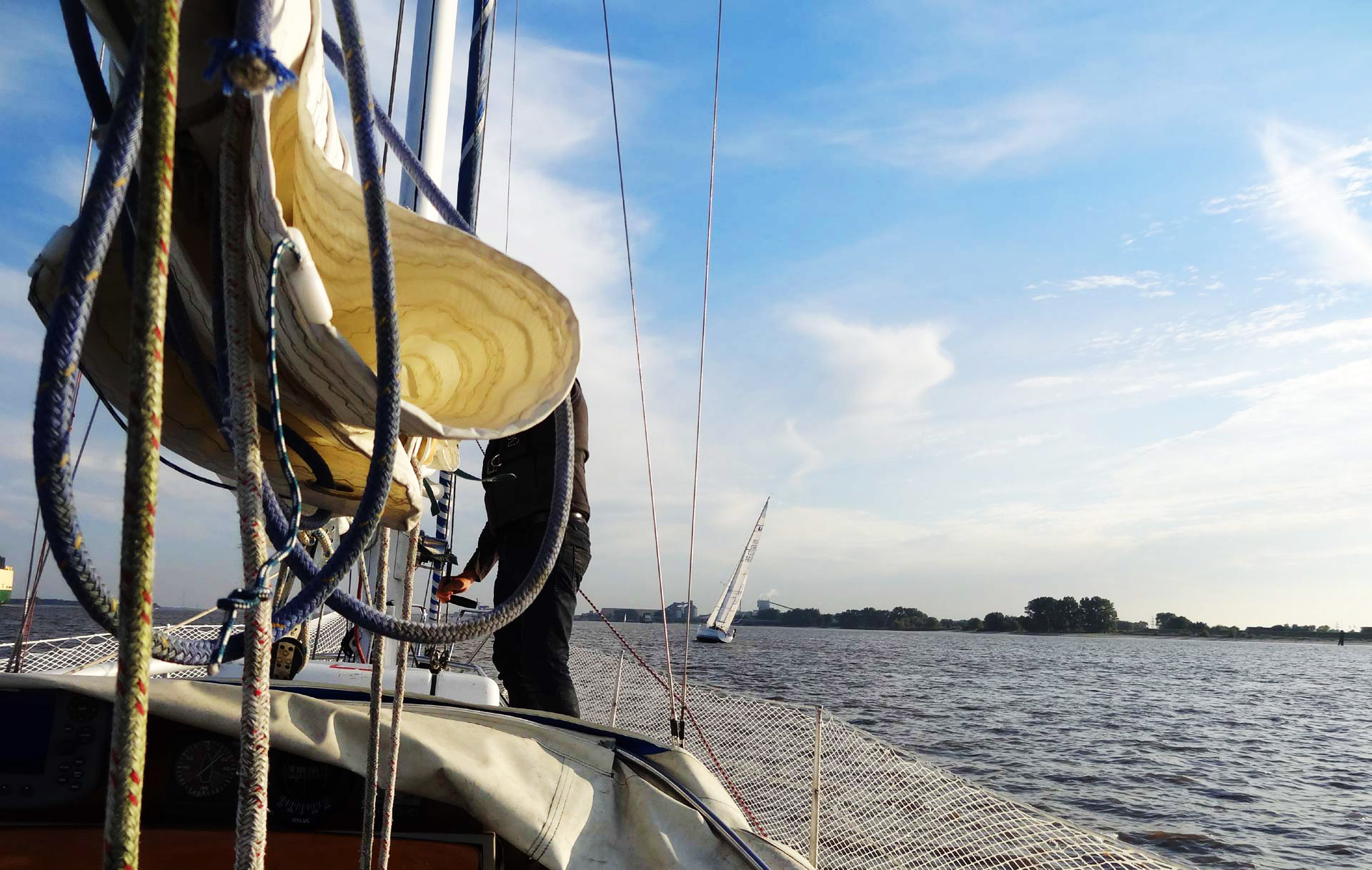
“So sailing alone was no option, Lars”, he further explained: “We were running at 7 knots best, mostly less. That´s too slow. Thatswhy we had the engine going full throttle as well.” But I remembered the struggle under sails we had the last hour or so too well: Shifting winds, too lazy and from an unfavourable direction. Sailing the Elbe upriver this time was unfortunately not an option.
At last: Under sails again.
I was shaking, not because of fear, but because of the heavy motion of our ship, holding my hands hard to the spar, trying to hook my feet between the deck structure to get more grip on our rolling boat: Taking down the mainsail and lashing it to the spar was a matter of minutes in the end, nevertheless I felt like one of the old mariners off Cape Horn high up in the masts during a heavy gale. “Take down the main”, the Pilot advised after we realized that sailing this time was impossible for us. Well, not impossible, but winds would blow from the wrong direction, forcing us to tack – which definitely was great fun, but a timeeater as well. And time was crucial today.
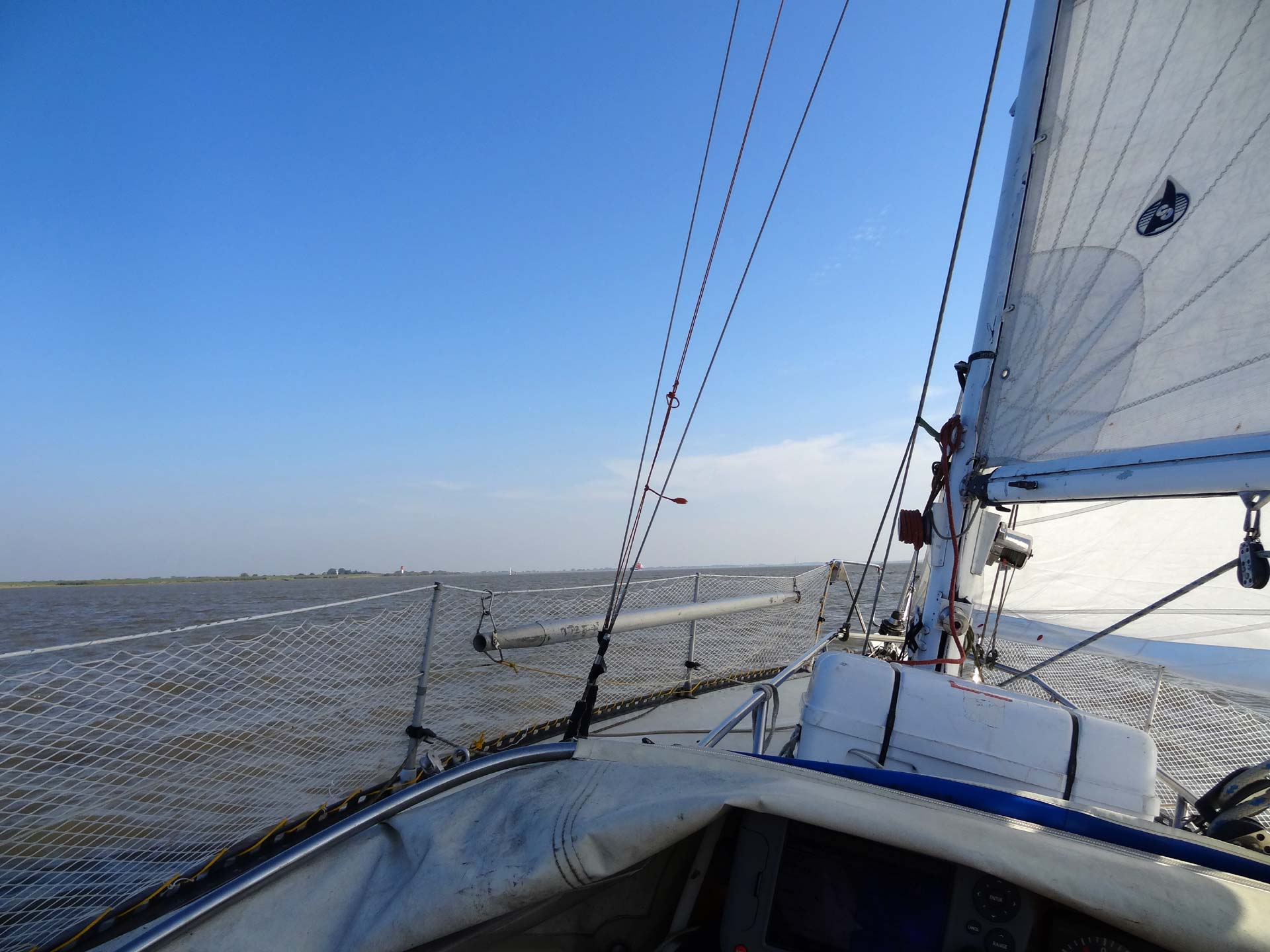
We kept the engine running all the way from Brunsbüttel locks anyway but our speed didn´t exceed 7 knots at best. “Too slow!”, the Pilot shouted against the roar of the wind, always taking a panoramic sight checking the commercial traffic. Before I took down the main, I had the Genoa rolled up again in a matter of seconds, thanks to Furlex, OLIVIA instantly came on even keel again. Seeing her taking away the canvas hurt in the heart. We went back to be a machine-driven ship again, which felt like being against her DNA.
Half an hour before we had a plan anyhow: Leaving Brunsbüttel locks, all the other yachts were instantly heading for the starboard-side of the waterway. This was right in terms of the traffic-laws, but strategically wrong, because we had wind blowing over from port side: “They are all sacrificing their height.”, the Pilot explained. “So, they´ll have to tack very soon to gain height again.” Ah, I understand: We stayed on the “wrong” side of the waterway, winning height and thus being able to sail before the wind to the starboard waterway buoy-line. Clever. I thought.
Having set all of her canvas brought some 55 squaremetres to the wind. She laid over smoothly to her starboard side, bringing everything to a steep angle. I noticed sharper motions which were caused by shorter waves. Looking at the waves I found them running from nearly every direction possible: There were waves blown by the force of the wind, other waves remainders of swell of the big ships – not visible anymore and long passed by but leaving their wake behind for longer times and increasingly the waves caused by the ever growing current of the flood.
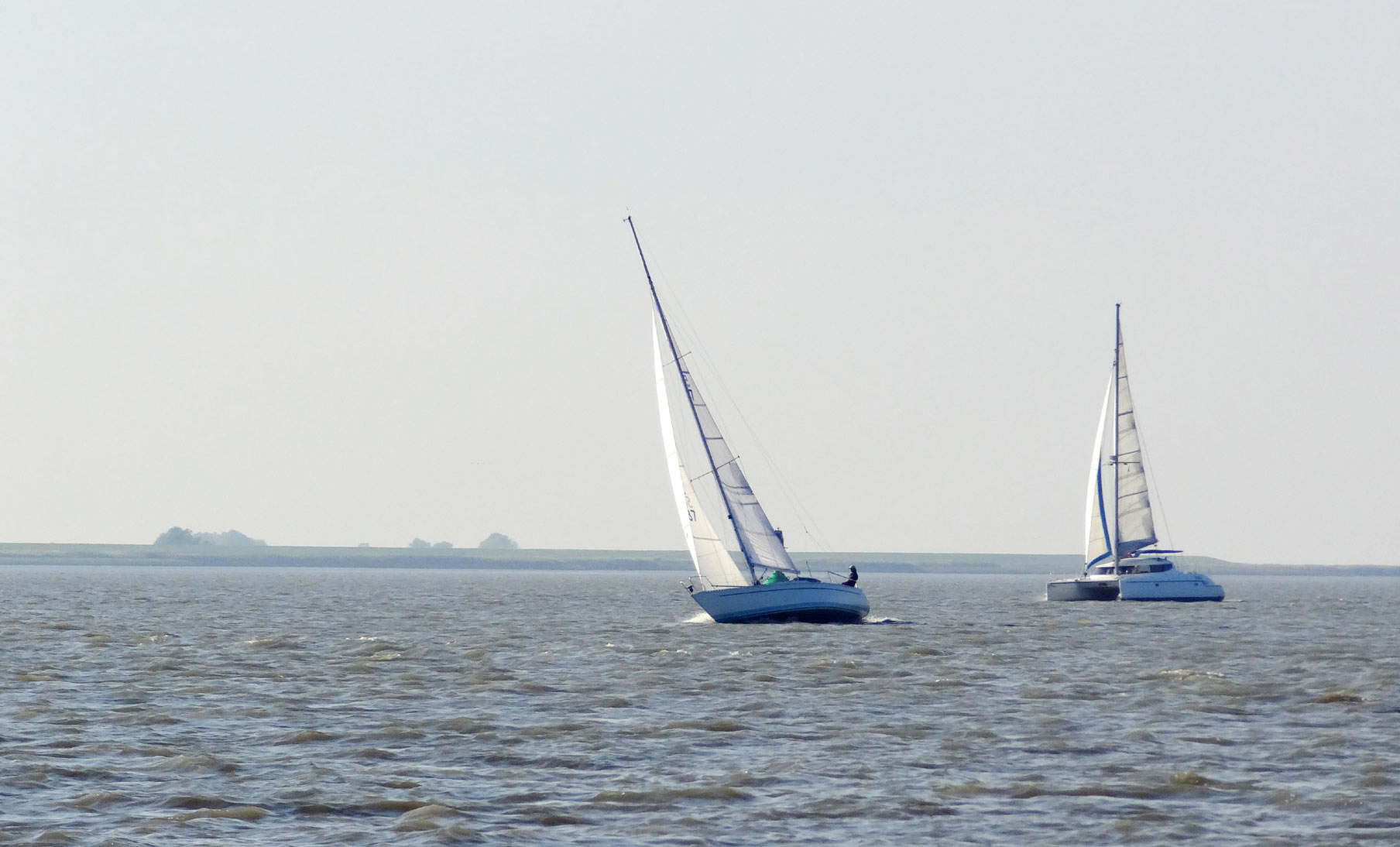
“Look at this buoy”, the Pilot pointed in one direction: “See the big bow wash over there at the buoy? That´s the flood!” Three knots. That sounds pretty slow. It´s a walking man´s speed. But seeing these 3 knots caused by the movement of a huge wave of water was impressive. The buoy leaned backwards in the current. “Steer her due west.”, the Pilot adviced another change of course. Instantly the log sprinted up: OLIVIA made 9.4 knots. “Yeehaw!”, I howled, thinking this condition won´t change until Hamburg.
But winds were lousy, blowing unconstantly and most of the time not very strong. Furthermore gusty, so unreliable, that we couldn´t stop our engine. “That´s a pity and I´m sorry”, said the Pilot at the helm: “I was hoping we could sail all along.” No problem, I answered: It´s fascinating too this way. But inside I agreed – a ship like our OLIVIA should be run with windpower solely. “Elbe is a tricky sailing area”, he explained: “You always have to keep a close eye on the tide, your timeframe and the traffic. No leisure-sailing here.” He was right: Our priority way reaching Hamburg today.
Mighty river Elbe.
“The water.”, I said to my wife, “Look at the colour of the water!” It was the first thing I noticed after we had left Brunsbüttel locks. Brown, sandy und opaque, the waters of River Elbe made a strong contrast to the desirable, sometimes Carribean-style bluish waters of the Baltic Sea we´d all around us just two days ago. Even compared to the green-yellow like water inside Kiel Canal this broth was not a pretty view to be honest.
Although we all were very relieved having arrived here: “Home waters!”, the Pilot whispered as we passed Brunsbüttel pierside, and it seemed like I was able to taste a smell of my city of Hamburg on my tongue. Looking at the levees to the left I remembered hundreds if not thousands of training kilometres on my racebike. “This used to be my training grounds”, I said, pointing towards the shore: “And it´s funny imagining, that I was three to four times faster on my carbon-bike than we are …” Well, my carbon bike didn´t weighed close to five tons and had to carry four persons, a wooden saloon and full provisions …

Being here on the Elbe again was a familiar view: How many times do we, as Hamburg citizen, take a more or less admiring look at this mighty river? But the difference today was the perpective: Now we were on that waters. Not besides them. We were the sailors we once longed to be when standing on the levees. I could easily spot dozens of strollers, could hear the baa of the sheep when winds were low. This is the right perspective, I decided. You should be on the water, not standing by and just watch.
In the north-west I could see a line of big commercial ships coming up. Having switched to Hamburg port radio frequency after leaving Kiel Canal, the Pilot could call them by their names. “Far away”, I said. “No, no”, he insisted: “They come up very fast. Not long ´till they reach us. Then watch out for their wake waves. They´re huge and violent.” I couldn´t imagine exactly what he meant, but had a regular look on them.
Coming up from behind we´ve had a Cat, running fast under sail with virtually no visible movement in her hull. The cat easily overtook another sloop yacht. Seeing both vessels close to each other in the same conditions, I was able to compare the differences between a very stable multihull, laying smooth in the water, having her mast upright straight in the wind – and the yacht, laying on her starboard side, working heavily in the waters. Both were overtaking us with ease: The Pilot laughed. “Strong engines, believe me. They´re not sailing either as well.”
Passing the locks in Brunsbüttel.
Having done the locking process in Kiel-Holtenau yesterday, Brunsbüttel was a no-brainer for us. Taking OLIVIA´s lines and securing her to the pierside next to a bigger Feeder-ship was a matter of minutes, the locking itself took only two or three minutes, the altitude difference barely visible on the walls next to myself. I wasn´t even able to shoot some nice pictures of our boat – we were through that fast that we didn´t even stop the engine.
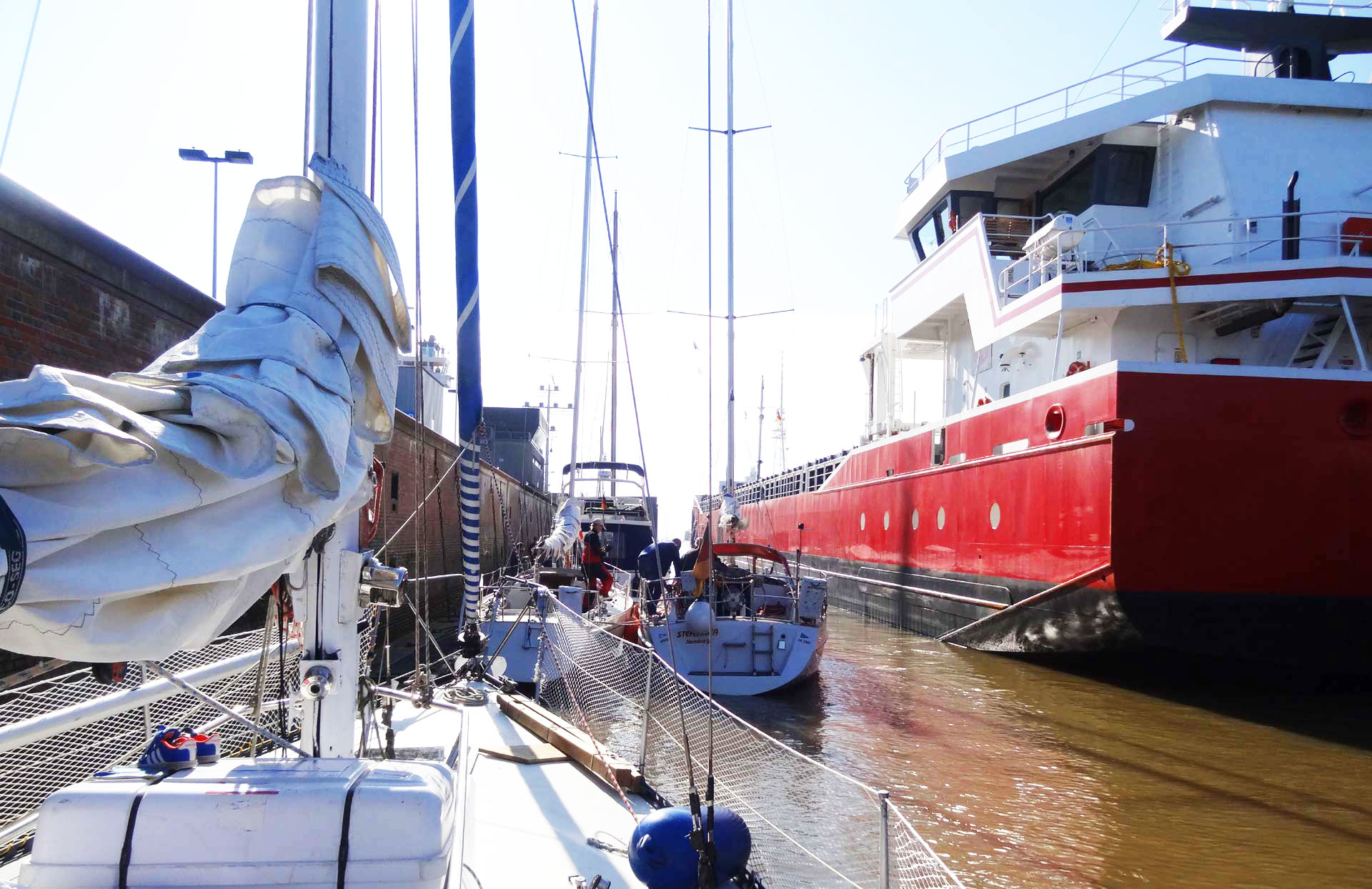
“Kiel Canal 4, this is SY OLIVIA”, the Pilot was radioeing the lock-controller: “Which lock and when can we expect for outbound-locking, over?” Timeframe was tight: With full throttle we had steered the last half an hour or so to be able to catch up with a Feeder-Freighter that overtook us some miles before Brunsbüttel. Knowing that only one out of four locks was operating – and bearing in mind that we must not miss the flood-wave. “Otherwise it could take us 10 instead of three or four hours to reach Hamburg.” Not a desirable prospect.
“Next locking is outbound, you can join on port side.”, came the answer. That was relief in his face. “Okay, let´s hurry not to miss this lock.” The alternative would have meant to stay inside Kiel Canal for another night. Which would have been sad for the Pilot´s scarce days off he was spending to accompany us, but as well interesting for me too: Brunsbüttel has a huge petro-chemical industry, and thus an interesting buzzling little port. “There´s a nice nice restaurant right next to the locks. A real sailor´s place.”, the Pilot was counting the alternatives. “Will be interesting to have dinner and beer there.” Well, might be. But I had the feeling, not this time.
A short sprint to Brunsbüttel.
Back on Kiel Canal we´ve had only a few more hours to go to Brunsbüttel. Our Penta was running steady on 2.800 revolutions and OLIVIA made some 6 knots. The fog was dissolving very fast and the sun came out quickly. There was much more traffic on the Channel than yesterday, I realized. We´ve had some bigger ships causing 33-feet OLIVIA going out of course everytime she had to climb their waves left behind in the wake of the big ships.

The Pilot was in good mood and had fun at the helm so I took some time off duty and placed myself in the foredeck, lay down to catch some of this year´s last sunrays. So did my wife and son. Here right above the bow if our ship there was virtually no sound of our Diesel running fast, just our boat making speed through the water, a constant splashing of a bow wash, stirring up the greenish waters of the Channel, leaving behind a trail of bubbles.
To bypass time with something useful I began to coil and order OLIVIA´s ropes and prepared the fenders for locking. The Pilot was listening to the radio messages, as always commenting and translating them for us non-sailors. Which freighter is coming towards us, which one to expect from behind. The more miles we did, the more regularly he began to take hasty looks onto his watch again: Feeling the tight schedule in his neck.
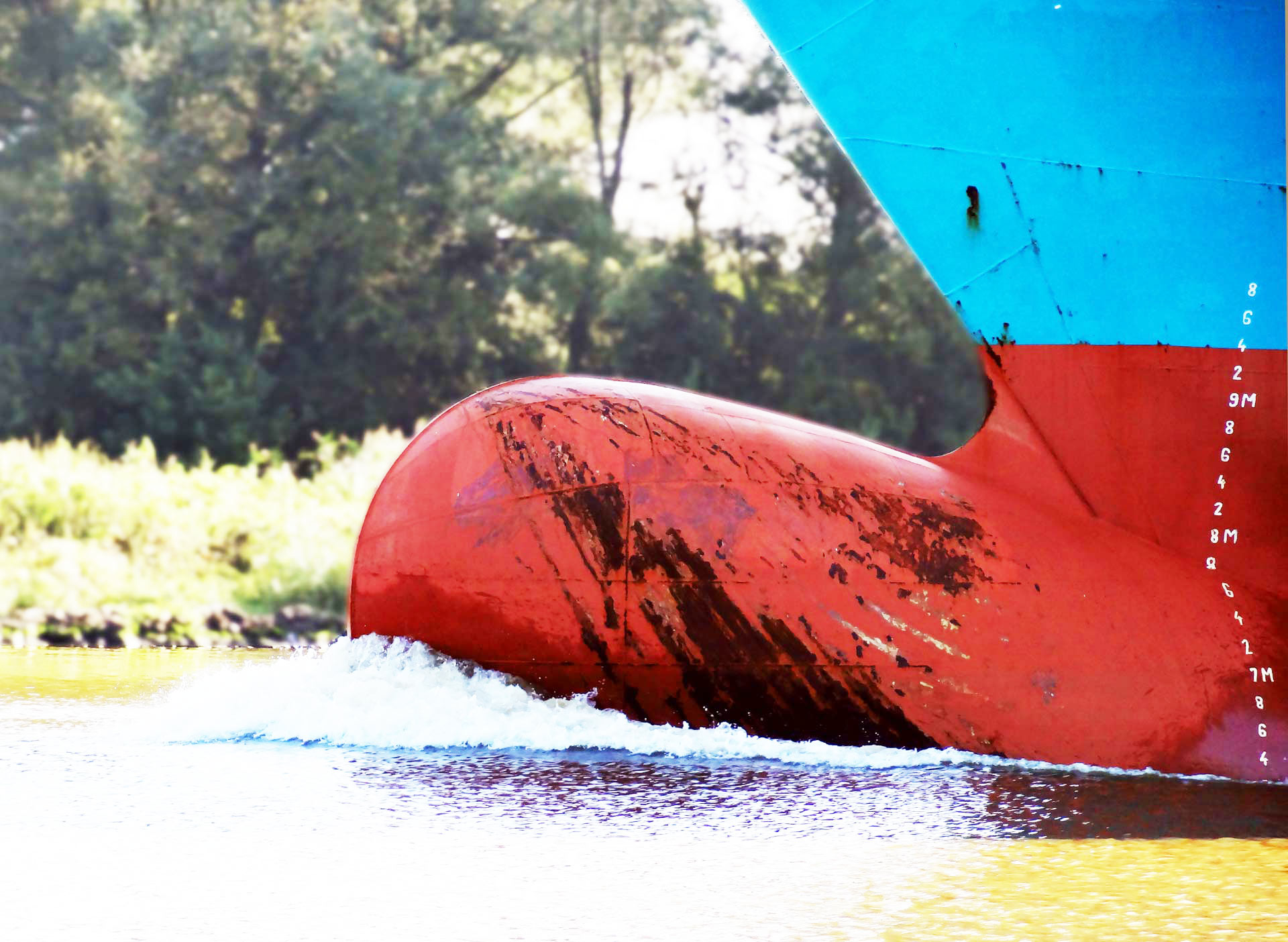
Weather was just perfect – not as warm as the days before, the air felt a bit more humid. But nevertheless, it promised to be a dry day and, most important, we didn´t had to expect dead-on headwind back out on River Elbe, which could mean that we´d be able to set sails again which I looked forward to very much.
We spent the last hours on the Channel with ease and leisure. Everyone was pretty much enjoying the time for him- or herself, trying to avoid too much or loud conversation. I got lost in the views of the beautiful nature, the Pilot enjoyed all the big ships and my wife and son were taking naps in the fresh air.
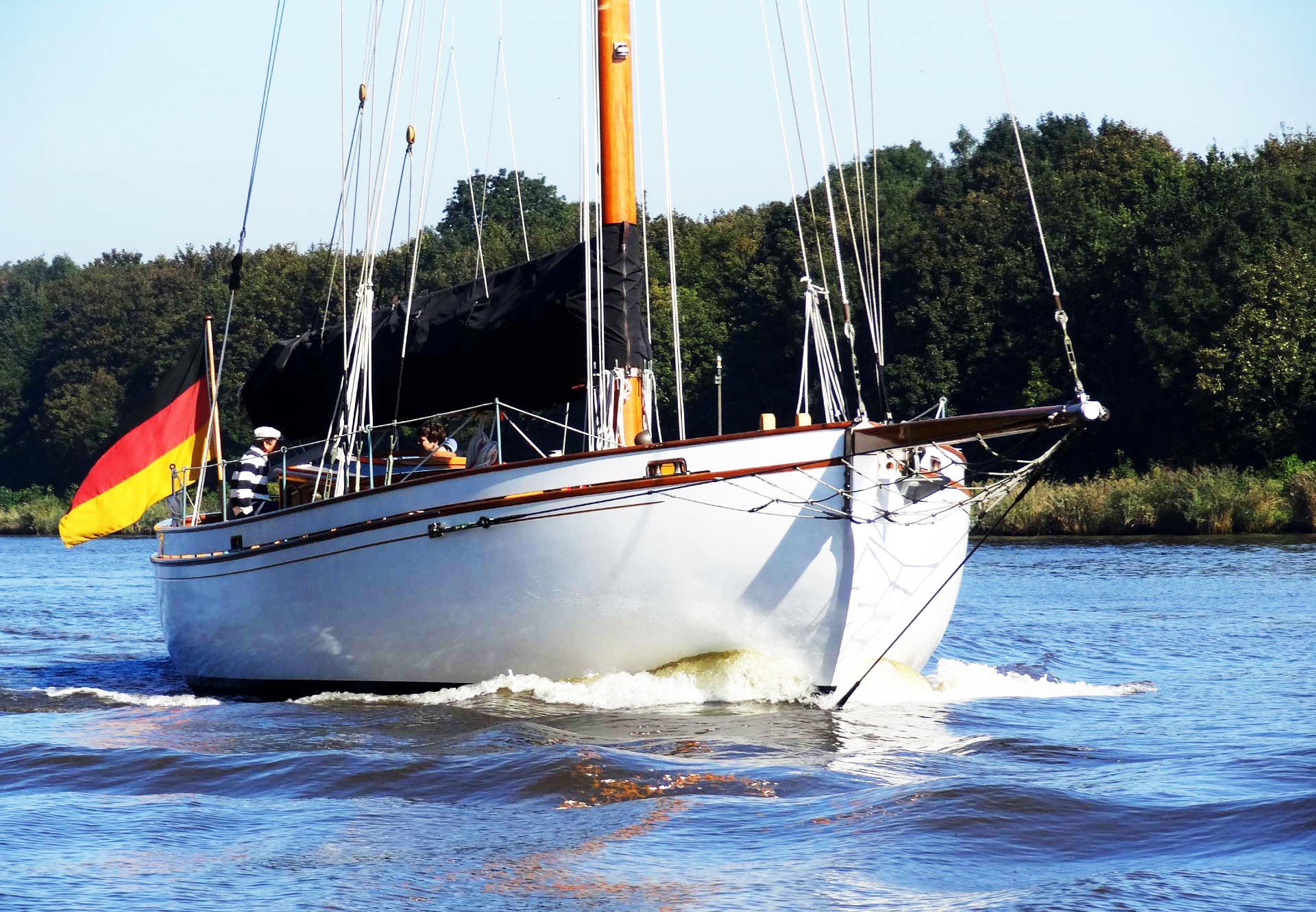
When finally the beautiful Gudrun III was overtaking us, her skipper and crew greeting, I knew that we´d have to squeeze out some more speed of OLIVIAs engine. Speaking of her engine. “What´s the filling level?”, I was asking. Since the gauge was showing the tank 75% full since three days we knew it was broken. The pre-owner asserted that he had filled up the Diesel prior to selling, but nobody knew how much gasoline our boat had consumed. There was no chance for bunkering Diesel after locking – thus making the level a crucial question. We tried to make some educated guesses, but the margin of error was too much.
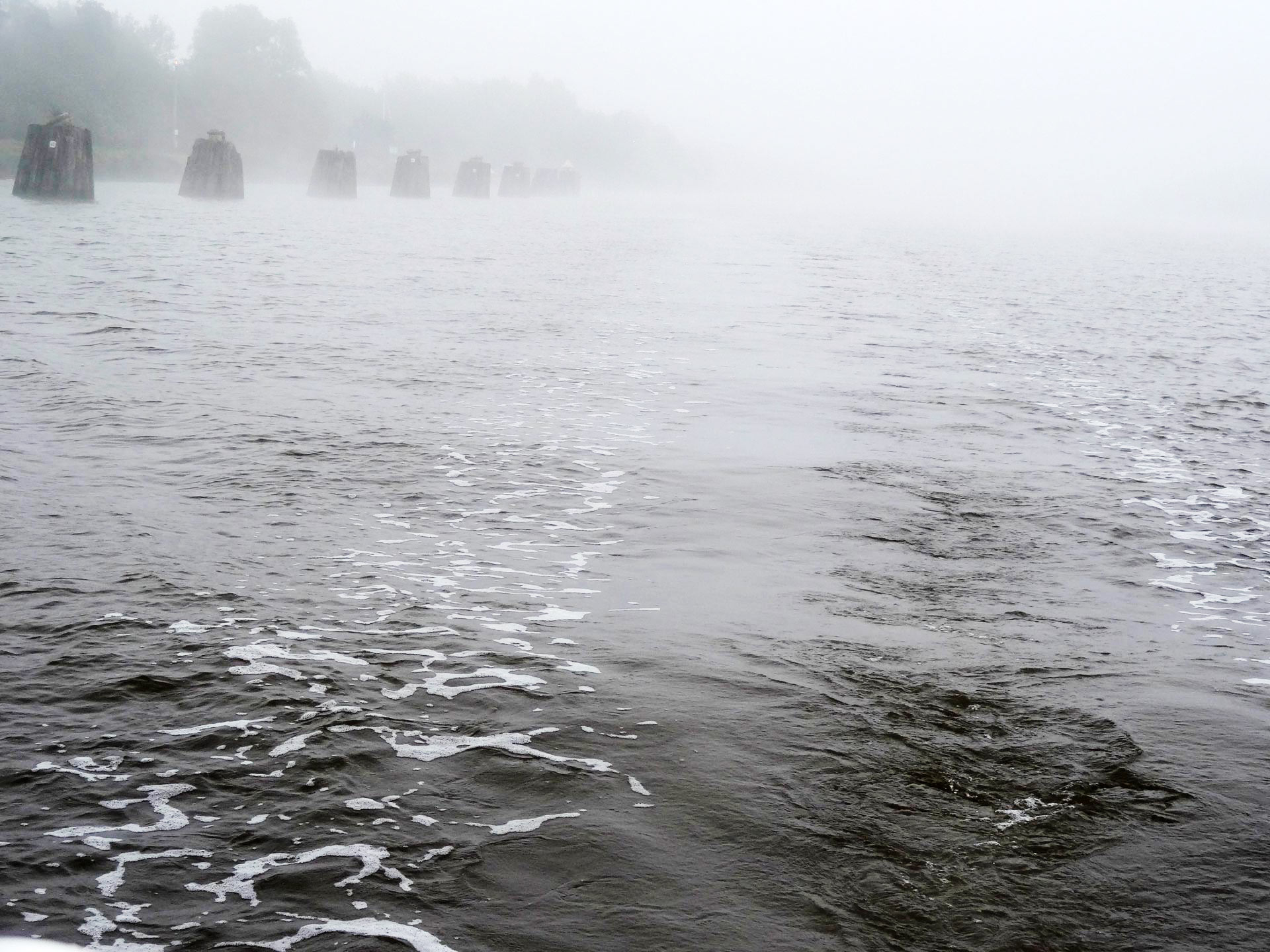
Disappering upside-down in the cockpit locker to his waist, the Pilot finally found the reason for the failing gauge: A short cicuit caused the instrument to show false numbers. Working again a sigh of relief came over my lips: Some 70% full. “We will reach Hamburg even if we´d have to run under engine all day long.” Pacifying. After craning and putting OLIVIA in winter storage (which can be read here) I filled up the tank up to the top: Out of 100 litres our trip has consumed only 45 litres. Amazing, given two days travel under engine.
Casting off in the fog.
We are the first yacht to cast off this morning. It´s cold, icy cold. As I wake up I can feel the condensed water all over my sleeping bag. Our windows and portholes are covered with a thin layer of water drops and when I opened the the ships a wave of cold, fresh air rolled down into the saloon. It´s half past 6 and my son was waking us up well in time. Here at Gieselaukanal all the other crews had still been asleep – going down the pierside to the bathrooms I noticed empty bottles of red wine next to most of the yacht´s entrances. Party time and headsickness.
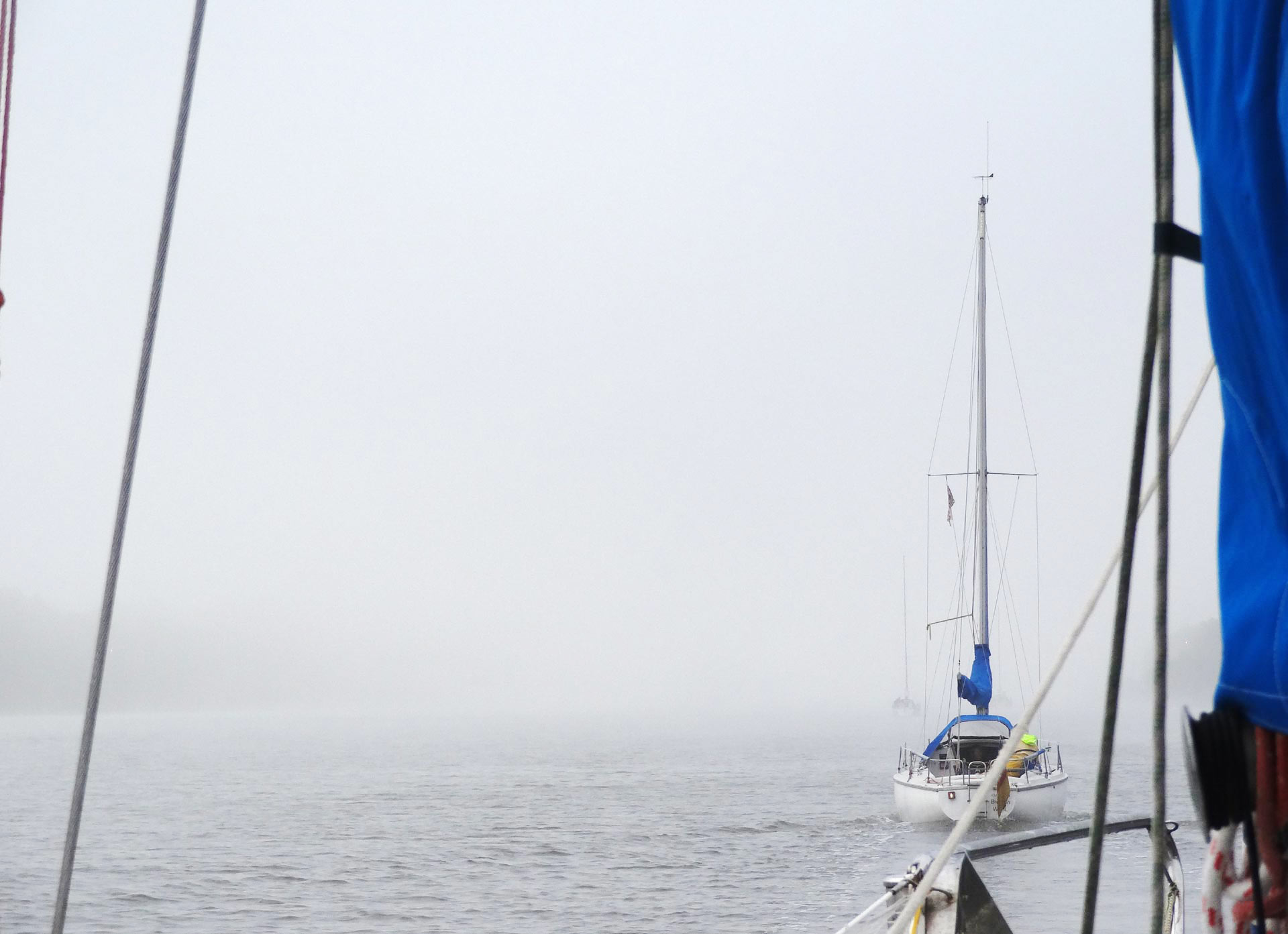
After having brushed our teeth I prepared a tasty breakfast: Scrambled eggs with fresh tomatoes and toast again, strong and hot coffee and whitebread with a thick layer of chocolate cream. Daylight was strong but no sun in sight – thick fog covered everything, dampering all sounds, even as most of the other crews of the 6 yachts got up as well.
“Last day of our cruise …”, I said. A bit feeling a melancholy in it all. I just got familiar with living on the boat. Got used to the scarce bathroom, shrunk down to the most necessary, the constant movement of the ship and the fresh air. Got used to living from dawn to sunset, to using the sailor´s language and after all to a solid, simple style of living. No luxurious deadweight – a huge gain in quality of life. No trash on TV – but conversations, learning to make enough of oneself. No fridge, microwave or washing machines, no stylish fashion – but the essence of life, of spending time together and enjoying nature.
In short: I loved it.
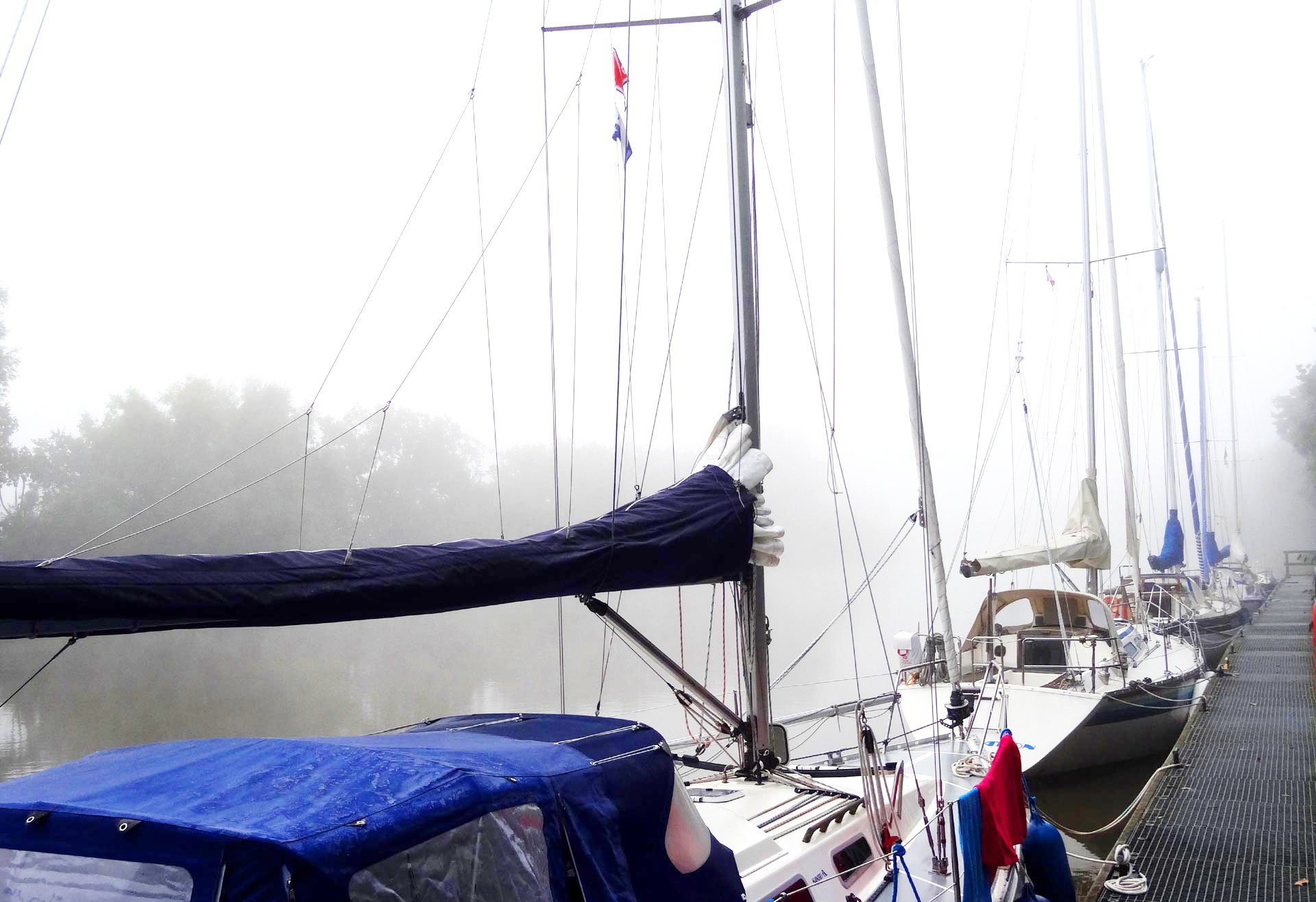
As OLIVIA was casting off, leaving her berth slowly, taking on speed to steam up the small Channel and turned to the right to head towards Brunsbüttel I looked back with sadness: In a few hours we would arrive back in Hamburg. This wonderful voyage would be over. “Be aware of the fog and do look out very strictly”, the Pilot reminded me. Another experience for me at the helm: Steering the boat through a white impenetrable cover of fog at virtually no sight was both thrilling and demanding.
A bittersweet Good bye. And big plans ahead …
That´s it. Transfer done. 130 miles. Only three days. A wonderful experience. Seamanship, sailing, navigation – having our first day spent completely under sail, quietly travelling 30 miles to Kiel and mooring at the famous Tiessen-Kai was an unforgettable first ever offshore-day. It will always remain in my memories as a perfect day.
Another tantalizing day running through Kiel Canal. I´ve learned so much about our new ship, her engine and behavior in heavy traffic with a bunch of other yachts sprinting all along. A perfect mooring in the Gieselaukanal and a quiet candle-light evening in our cosy saloon.
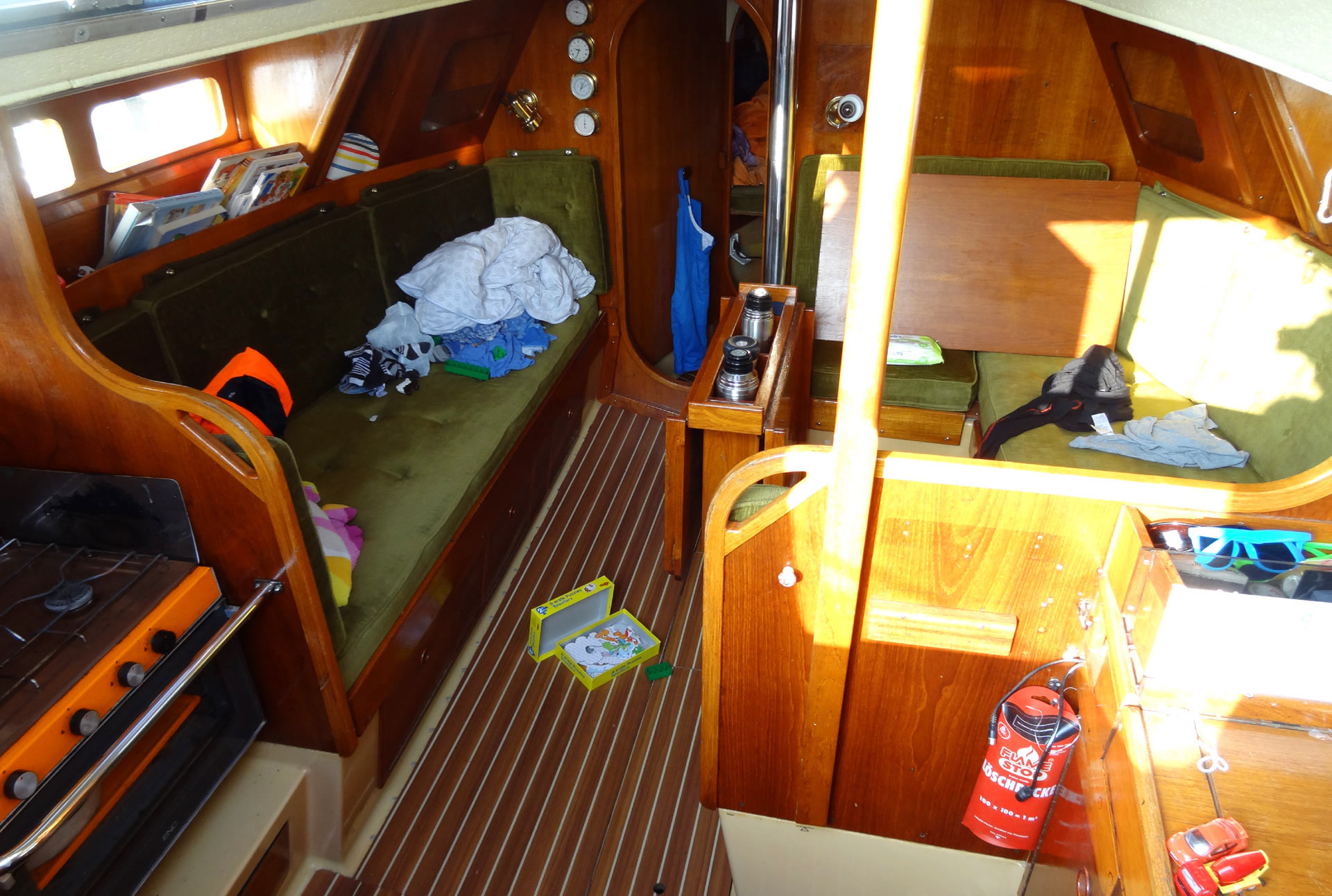
And now, having my boat secured on dry land, three weeks after having brought her safely to Hamburg, it´s just a bunch of pictures and so many memories that I will hopefully never forget. Big plans ahead: A complete overhaul of OLIVIA´s interior and ideas of her in the upcoming sailing season: Helgoland, Germany´s one and only offshore island, the islands of Sylt or Romö, the danish coast-line up until Skagen … and so much more keeps flashing up in my mind.
But this one thing will remain forever present in my mind: That first ever trip with our fine King´s Cruiser 33.
Dear Pilot, I´d again like to express my deepest gratitude for being our Captain before and during the trip. Without your expertise we´d never had reached Hamburg both that fast and safe. I look forward to welcoming you on board OLIVIA again anytime you wish.
What are your memories of your first ever sailing cruise? I look forward to your comments.

